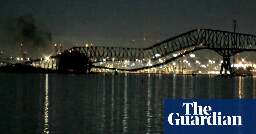Baltimore bridge collapses into river after being hit by cargo ship


A portion of the Francis Scott Key Bridge in Baltimore has collapsed after a large boat collided with it early on Tuesday morning, sending multiple vehicles into the water.
At about 1.30am, a vessel crashed into the bridge, catching fire before sinking and causing multiple vehicles to fall into the water below, according to a video posted on X.
“All lanes closed both directions for incident on I-695 Key Bridge. Traffic is being detoured,” the Maryland Transportation Authority posted on X.
Matthew West, a petty officer first class for the coastguard in Baltimore, told the New York Times that the coastguard received a report of an impact at 1.27am ET. West said the Dali, a 948ft (29 metres) Singapore-flagged cargo ship, had hit the bridge, which is part of Interstate 695.
Good luck finding the necessary crane capacity. There are a handful of seriously big cranes in the 7000 tons plus range, but they are Dutch or Japanese, primarily. Wherever they are, they are probably busy and will take ages to get there. While the weight/mass of the bridge is not available online, it surely exceeds the weight limits of cranes currently in existence by far, so the bridge segments need to be cut up prior to removal.
Even if the US spends insane amounts of money, this issue will take quite some time to resolve.
You're not lifting it out of the way, you're gonna pull it out of the way with a tugboat.
It still is thousands of tons of steel, which will not be pulled that easily. And it is steel that does not swim, but drag along the muddy ground.
You cut it into pieces, add some buoyancy things. Naval operations can be impressive. Hell the Navy probably already has stuff to do this exact thing in case of war and a bridge out of Port gets destroyed. You don't want your Navy blocked in. You also don't need to move it far to get shipping back.
The "cut into pieces" will be interesting. There are a shitload of large pieces, and everything is under tension. The links between the pieces are rather large, and a good amount of them are under water. That's going to be serious work.
Feels like an army corps of engineer training exercise, especially after Biden committed to help rebuild. Be really interesting engineering coming out of both the cleanup, rebuild, and post accident analysis.
Cleanup will probably be Navy, rebuild will be civilian. Analysis is simple, ship lost power and hit the pier. Ships that size not sure you can do much.
I get the distinct impression that you have zero engineering knowledge or experience.
Or I'm trying to keep it concise.
Well, in that case you're being too vague because I have no idea what you are talking about.
not the original commenter, but they used some buoyancy things to lift a section of the titanic, obviously thats very different, but i think they are like large bags that can be filled with air to lift incredible weight underwater.
You mean the 14,000kg "big piece" that required two separate attempts to retrieve (by the same guy who piloted the doomed Oceangate sub)?
The floation bags were only necessary because the piece was on the bottom of the ocean beyond where any crane could reach. In some respects this seems to make the bridge cleanup a bit easier, but it wasn't the floatation bags that caused the first attempt to fail, it was the weight of the piece itself making it hard to capture with the class of tugboat they were using.
The second attempt succeeded only because they used this massive tugboat:
While the weight of the Key Bridge is not publicly known, it is likely thousands of times more massive than The Big Piece. For comparison the Golden Gate Bridge has a similar length of 1.7 miles (to Key Bridge's 1.6 miles), 6 lanes (to the Key Bridge's 4), and weighs 382,000,000kg. Assuming the Key Bridge only weighs half of what the Golden Gate does, it would weigh about 13,500 times more than The Big Piece. On top of that it is collapsed into a tangled mess and needs to be cut into pieces small enough to remove while it is underwater.
The resources needed to make this happen are going to be insane. It is going to take months before there's enough clearance to safely let more cargo ships through safely.
yeah, i dont know enough about marine salvage to comment anything worthwhile, but it certainly will be interesting to see what they do, and how fast.
The Left Coast Lifter is in NY and can be on site in about 24-30 hours depending on currents going up Delaware Bay. It can make picks up to approx 1,600 tons, it would laugh at what the Key bridge weighs.
https://en.m.wikipedia.org/wiki/Left_Coast_Lifter
At a 1,600 tons limit, one would have to cut the debris into a lot of small pieces. There is no info on the net on how much mass the Key bridge had, but assuming the build and the size, half a million tons is probably not to far off.
It won't come out in one piece, but it can come out in much larger pieces with a big crane. This one specifically was used to build bridges and put in far larger sections than this job would require. Smaller crane barges will work on the smaller pieces simultaneously. They'll clear half the channel (most likely the section away from the Dali) and open it to one-way traffic while they continue clean up.